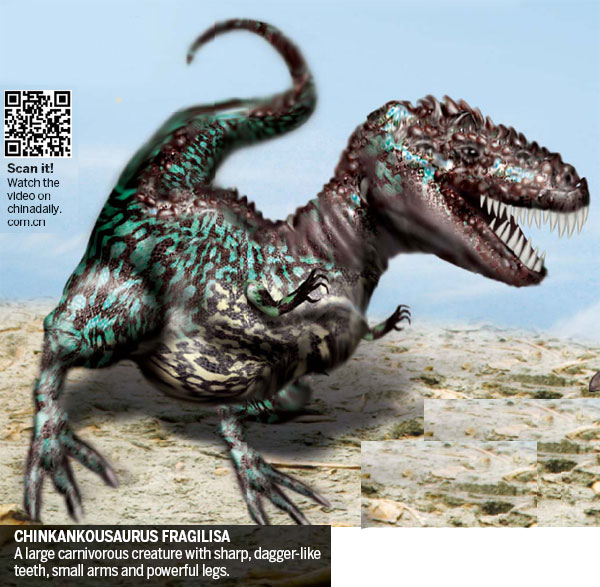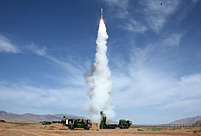 |
| (China Daily) |
Scientists are conducting research on a site where an earlier generation of paleontologists had first begun their work, with the hope of unveiling more of the story from the Late Cretaceous period, Cheng Yingqi reports
The village of Jingangkou, 10 km southeast of Laiyang, Shandong province, is like any farming community. Houses dot the landscape of green patchwork fields. Vegetables grow in the lush soil. But the mountains surrounding the village hold an archeological treasure - large bleached bones. After two months of digging in the red mountainous terrain, paleontologists have excavated more than 200 dinosaur bones since July. "The soil of Laiyang has preserved the most complete remains of dinosaurs living from the Late Cretaceous period (100 to 66 million years ago)," said Wang Xiaolin, a professor of the Institute of Vertebrate Paleontology and Paleoanthropology at the Chinese Academy of Sciences.
"And what makes this site so important is that it is one of the few sites that are rich both in dinosaurs and in dinosaur eggs."
Wang and his team have been carrying out research in Laiyang since 2008.

 Storms leave 97 dead, 58 missing in Mexico
Storms leave 97 dead, 58 missing in Mexico New model of indigenous surface-to-air missiles testfired
New model of indigenous surface-to-air missiles testfired  118.28-carat diamond to be auctioned in HK
118.28-carat diamond to be auctioned in HK Maternal love under streetlight
Maternal love under streetlight Naked foreign student sits in the middle of a road in Haikou
Naked foreign student sits in the middle of a road in Haikou  Colorful Yunnan: Enjoy the natural beauty
Colorful Yunnan: Enjoy the natural beauty Harbin named Chinese city with most beautiful women
Harbin named Chinese city with most beautiful women New college students' military training in Guangzhou
New college students' military training in Guangzhou Rugby girls
Rugby girls PLA's 38th Group Army conduct training
PLA's 38th Group Army conduct training Residences of the royal house of Savoy
Residences of the royal house of Savoy The last days of Wan Aihua
The last days of Wan Aihua Highlights at 12th National Games of China
Highlights at 12th National Games of China Beijing Film Academy welcomes freshmen
Beijing Film Academy welcomes freshmen Large mahjong party sets new world record
Large mahjong party sets new world recordDay|Week|Month